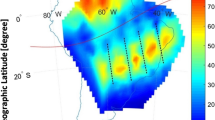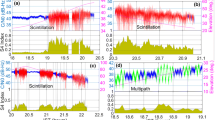Abstract
An incident has previously been reported where the signal from the Navstar 43 Global Positioning System (GPS) satellite contained phase anomalies in such a way as to mimic ionospheric scintillation. We have observed another 25 events from the same satellite, plus events from three more satellites. Our data includes simultaneous observations from widely spaced receivers (up to 6,590 km apart), from different manufacturers, further ruling out the possibility of local effects. Two of the events involved a satellite (GPS IIF SV-2) broadcasting the L2C signal. This signal contained phase deviations matching those of the L1 signal, but with a 120/154 multiplicative factor. This rules out the possibility of a genuine ionospheric scintillation event, as it does not match the plasma dispersion relation. It does, however, agree with what can be expected from an anomaly in the satellite’s oscillator. While the previously reported event could be dismissed as a freak occurrence, it is now apparent that these events are a persistent phenomenon. They have the potential to corrupt geophysical research with false data and to generate false alarms in systems to forewarn of GPS outages due to scintillation.





Similar content being viewed by others
References
Benton CJ, Mitchell CN (2012) GPS satellite oscillator faults mimicking ionospheric phase scintillation. GPS Sol 16:477–482
Bhattacharyya A, Yeh KC, Franke SJ (1992) Deducing turbulence parameters from transionospheric scintillation measurements. Space Sci Rev 16:286–335
IS-GPS-200F (2011) Revision F of the interface specification IS-GPS-200 document, www.gps.gov/technical/icwg/
Kaplan ED, Hegarty CJ (2006) Understanding GPS principles and applications. Artech House
Skone S, Knudsen K, de Jong M (2001) Limitations in GPS receiver tracking performance under ionospheric scintillation conditions, Proceedings of the first COST action 716 workshop towards operational GPS meteorology and the second network workshop of the international GPS service (IGS)
Van-Dierendonck AJ, Klobuchar J, Hua Q (1993) Ionospheric scintillation monitoring using commercial single frequency C/A code receivers. In: Proceeding of ION GPS-1993, The Institute of Navigation, Salt lake City, Sept, pp 1333–1342
Acknowledgments
We received financial support from the Engineering and Physical Sciences Research Council (grant EP/H003304/1). We acknowledge useful conversations with A. J. Van-Dierendonck and Karl Kovach. We thank the staff at the Cape Verde Atmospheric Observatory and the Ramfjordmoen EISCAT station for their assistance in hosting our equipment. Figure 1 incorporates public domain imagery, courtesy John Harvey.
Author information
Authors and Affiliations
Corresponding author
Rights and permissions
About this article
Cite this article
Benton, C.J., Mitchell, C.N. Further observations of GPS satellite oscillator anomalies mimicking ionospheric phase scintillation. GPS Solut 18, 387–391 (2014). https://doi.org/10.1007/s10291-013-0338-4
Received:
Accepted:
Published:
Issue Date:
DOI: https://doi.org/10.1007/s10291-013-0338-4




